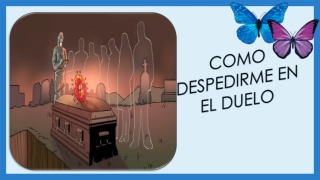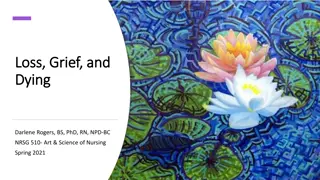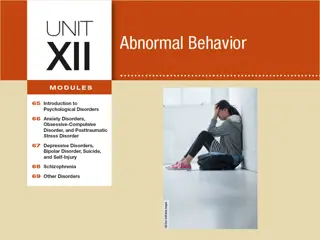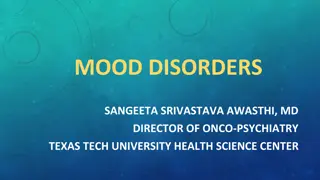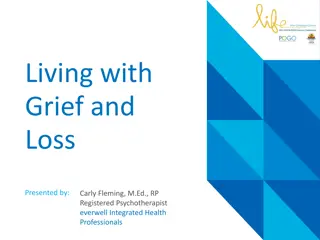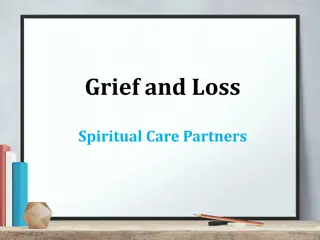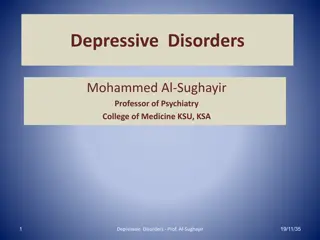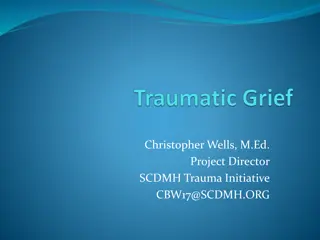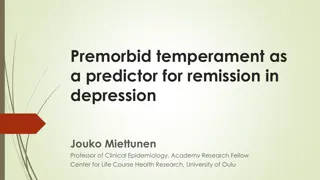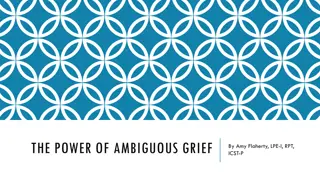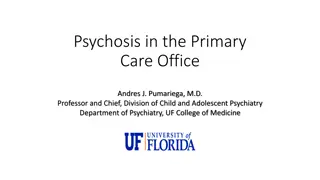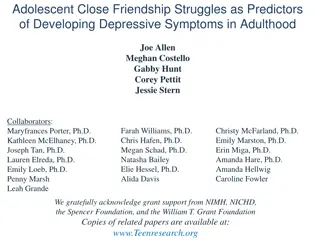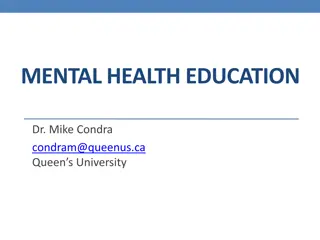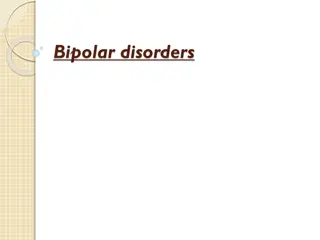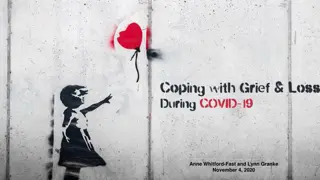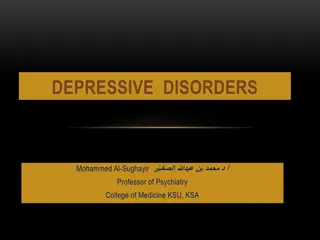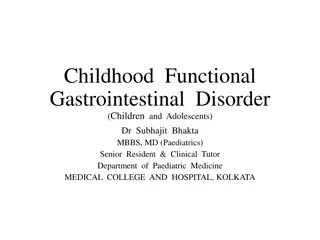Understanding Grief and Depressive Disorders: A Comparative Analysis
Grief and depressive disorders share similarities but also have distinct differences. Grief is a universal emotional state following loss, while depressive disorders involve prolonged mood disturbances. The stages of grief include denial, anger, bargaining, depression, and acceptance, with interventions such as promoting expression of pain and individualized care. Symptoms of mood disorders include excessive hostility, emptiness, and inability to resume normal activities. Effective nursing care involves understanding individual grieving processes and applying appropriate treatment strategies for mood disorders.
Download Presentation

Please find below an Image/Link to download the presentation.
The content on the website is provided AS IS for your information and personal use only. It may not be sold, licensed, or shared on other websites without obtaining consent from the author. Download presentation by click this link. If you encounter any issues during the download, it is possible that the publisher has removed the file from their server.
E N D
Presentation Transcript
Compare and contrast grief to depressive disorders Identify stages of the grieving (mourning)process Relate interventions appropriate to the grieving process Identify symptoms and behaviors associated with mood disorders Analyze predisposing factors and/or precipitating stressors to mood disorders Apply the nursing process in the care of persons with mood disorders Describe the treatment strategies for mood disorders and the implications for the nursing role
Grief is universal Grief is the subjective state that follows loss A powerful emotional state that affects all aspects of a person s life Grief can continue for months, 1-2 years
Types of loss Particularly the loss of a loved one Other types of loss Physiologic Safety Security Self-esteem Self-actualization
Uncomplicated bereavement (normal grief) this is not a disorder Anticipatory grieving-grief associated with anticipation of predicted loss or death Disenfranchised grief involves a loss not typically acknowledged by society (e.g., a pet, a home) Chronic sorrow-grief associated with ongoing loss such as chronic mental or physical illness
Normal mourning process: Denial Anger Bargaining Depression Acceptance
Individuals grieve in different ways Stage/phase of grief determines intervention Developmental stage effects grief process Nurses have role in helping persons who are grieving
Excessive hostility and bitterness Prolonged emptiness and numbness Inability to weep or express emotion Failure to resume activities, work, go on with their lives
Understanding Promote expression and release of pain Use of the therapeutic relationship/communication Individualization of care, recognizing various beliefs and practices r/t loss such as death Culture, religious practices, and spiritual beliefs
Listen Express sympathy Avoid clich s and minimizing Spiritual care Support groups
Grief counseling Traumatic grief psychotherapy
Grief can look very much like depression (overwhelming sadness, poor sleep, poor concentration, decreased appetite, somatic complaints) Unlike depressed persons, the grieving person does not have poor self-attitude, worthlessness Grief can progress to Major Depression
Feelings of emptiness and loss Depressed mood and/or inability to anticipate happiness or pleasure Persistent Pangs (or waves) of grief Positive emotions and humor Preoccupation with the deceased (loss) Pervasive unhappiness Pessimism GRIEF DEPRESSION
Depressive Disorders Major Depressive Disorder Postpartum Depression Seasonal Affective Disorder Dysthymic Disorder Bipolar Disorders I II Cyclothymic Disorder
Mood - Pervasive and sustained emotion that colors one s perspective of the world and how one functions in it
20.9 million American adults (9.5% of the population) have a mood disorder in a given year Median age of onset 30 years old Depressive disorders often co-occur with anxiety and substance abuse
20% of people will experience depressive illness in their lifetime Prevalence rates not affected by race Leading cause of disability among ages 15-44 y.o. Effects 14.8 million (6.7 % of the U.S. population) in a given year Median onset is 32 y.o. More prevalent in women than men, 2:1 Incidence higher in young women, increasing in adolescents, increases with age among men
For at least 2 weeks a depressed, sad mood and/OR loss of interest & pleasure (anhedonia) with 4 of the following: Appetite/weight change * Sleep disturbance daily Psychomotor agitation or retardation (observed by others) Fatigue/low energy daily Guilt or feelings of worthlessness daily Poor concentration or indecisiveness daily Recurrent thoughts of death, suicidal ideation
Anger/irritability Anxiety Apathy Withdrawal Denial of feelings Despondency Loss of motivation Guilt Helplessness Hopelessness Loneliness Low self-esteem Pessimism Bitterness Self-destructive thoughts/behaviors
Sleep disturbances Menstrual changes Sexual problems Weight change Abdominal pain Backache Chest pain Dizziness Fatigue Headache GI disturbances
Ambivalence Confusion Inability to concentrate- can t think, can t focus Indecisiveness and uncertainty Cognitive distortions Impaired (short-term)memory Negative thinking (self-blame, deprecation, destructive) May include psychosis psychosis
Aggressiveness/agitation Alcohol/drug abuse Altered activity level/psychomotor retardation Over- dependency Poor hygiene Underachievement Withdrawal
Prior episodes of depression Family history of depression Prior suicide attempts Female gender Postpartum period Medical comorbidity Lack of social support Life stressors Personal history of sexual abuse Current substance abuse
Multifactorial: Genetic/biological Environmental- Life stressors, loss Poor attachment in infancy/early childhood (object relations) Learned helplessness/hopelessness
Decrease in monoamine neurotransmitters (Norepinephrine, Serotonin) in the synapse between neurons Over-Activation of the HPA axis Stress hypothalamus secretes CRH stimulates pituitary to release ACTH stimulates adrenal cortex to release glucocorticoids damages neurons decrease in neurotransmitters depression and anxiety
Psychiatric evaluation Self-report of symptoms Family report of symptoms Signs of depression (decreased sleep, decreased appetite, etc) Medical exam to rule out physical illness Labs TSH, T3, T4, CBC must rule out medical causes such as hypothyroidism Screening tools
Hamilton Rating Scale for Depression (HAM-D) (1967) Primary Care-Screener for Affective Disorders (PC- SAD) (Rogers et al, 1998) Primary Care Evaluation of Mental Disorders (PRIME- MD) (Spitzer, et al., 1994) Symptom-Driven Diagnostic System for Primary Care (SDDS-PC) (Broadhead et al., 1995) Beck Depression Inventory (BDI) 1988 Child Depression Inventory Zung Self-Rating Depression Scale (1965)
Impaired relationships Inability to perform usual activities Loss of productivity Alcohol and other substance abuse Increased use of health care resources Risk of suicide (about 15% of patients with severe depression commit suicide)
More common in women Hormones directly effect the brain Vulnerability to postpartum depression Premenstrual dysphoric disorder Increased risk during transition to menopause Additional stresses at work, home, caring for children and aging parents, abuse, poverty, relationship strains
13% of all new mothers Associated with drastic hormone changes Higher risk with previous PPD, h/o mood disorder Estradial for treatment
May experience differently Feel tired, irritability, anhedonic, poor sleep, get frustrated, angry More likely to use alcohol/drugs Avoid talking about it Excessive work Behave recklessly More likely to complete a suicide
More medical conditions that are associated with depression (e.g., cardiac, Parkinson s, stroke, cancer) Medications with SE of depression Older white males age 85 + have the highest suicide rate in the U.S. Psychotherapy and medications are effective treatments
Children may pretend sick, refuse school, cling to a parent, worry about a parent dying Older children may sulk, get into trouble, be negative and irritable, feel misunderstood Before puberty, no difference in incidence based on sex By age 15 y.o., girls twice as likely as boys
In the teen years, often co-occurs with anxiety, eating d/o s, or substance abuse Childhood depression often persists into adulthood, esp. if not treated
Mood disorder due to medical condition Endocrine dysfunction Hypo- or hyperthyroidism Cushing s disease Degenerative/structural change Parkinson s Huntington s Disease MS TBI Stroke Substance-Induced Mood Disorder Seasonal Affective Disorder (SAD) Adjustment Disorder (situational) Seasonal Affective Disorder (SAD)
Less daylight during the fall and winter causes depression in some people. Overproduction of melatonin disrupts our internal body clock leading to depressive symptoms. If you have had episodes of depression that clearly have an onset in fall or winter followed by remission of symptoms in the spring or summer, you may have SAD.
Depressed mood Irritability Hopelessness Anxiety Loss of energy Social withdrawal Oversleeping (feeling like you want to hibernate) Loss of interest in activities you normally enjoy Appetite changes, especially a craving for foods high in carbohydrates such as pastas, rice, bread and cereal Weight gain Difficulty concentrating and processing information
Characterized by chronic low-level depression experienced for at least 2 years Not as severe as MDD, but can prevent normal functioning and feeling well 1.5 % of the adult population in the U.S.
Safety - Environment free of harmful objects, safety plan Pharmacology antidepressants, sleep aids, short term anxiolytics Psychotherapy Cognitive Behavioral, Interpersonal, Solution Oriented, Supportive Education- Coping skills, self esteem, illness, medications, resources Phototherapy - Artificial bright light for SAD* Electroconvulsive therapy (ECT)*
Unlike adults, children may not respond to tricyclics. Children and adolescents do respond well to SSRIs and perhaps to other classes of antidepressants as well. In 2003 a blackbox warning was implemented r/t increased suicide risk. More recent reports (June 2014) indicates an association between decrease rx and rise in child/teen suicide attempts
Usual adult daily dosage ranges (not recommended for children): Phenelzine (Nardil): 30-60mg Tranylcypromine (Parnate): 20-60mg Selegiline (Eldepryl, Atapryl) 10mg Indications: may be useful in the treatment of depressed patients with marked anxiety or phobic symptoms. Selegiline is also used for the treatment of parkinsonism. Because of the potential for serious adverse effects, MAOIs are not commonly used in clinical practice.
Pharmacokinetics: antidepressant effects may take 3-6 weeks Most frequent adverse effects: orthostatic hypotension, insomnia, weight gain, edema, and sexual dysfunction. Rare side effect: tyramine-induced hypertensive crisis. Avoid foods that are preserved, pickled or aged (e.g., aged cheese, cured meats or fish, alcoholic beverages) Potential for severe drug-drug interactions
Elavil (amitriptyline) Norpramin (desipramine) Pamelor (nortryptyline) Pertofrane (desipramine) Sinequan (doxepin) Tofranil (imipramine) Anafranil (clomipramine) - OCD
Depression Anxiety disorders Obsessive-compulsive disorder Clomipramine (Anafranil) Chronic pain: Neurogenic pain, Trigeminal neuralgia, Diabetic neuropathy, Sciatica, Fibromyalgia Sleep Disorders Insomnia, Cataplexy
Pharmacokinetics: therapeutic effects within 3-4 weeks; improved energy and sleep in 1-4 weeks Adverse effects: Anticholinergic: dry mouth, blurred vision, constipation, memory effects Antiadrenergic: orthostatic hypotension Antihistaminergic: sedation & weight gain Cardiac: use in patients with conduction defects is contraindicated Because of the potential for severe side effects and even death, TCAs are relatively contraindicated in the elderly, children, pregnant women and suicidal individuals.
Adolescents often receive adult dose, but doses are slightly less for children. Fluoxetine (Prozac): 20-80mg/day for depression and anxiety disorders; 60-80mg/ day for bulemia. Prozac weekly: 90mg. Fluvoxamine (Luvox): 100-300mg/day for OCD; 100-200 mg/day for depression Paroxetine (Paxil): 20-50 mg/day Sertraline (Zoloft): 50-200 mg/day Citalopram (Celexa): 20-60mg/day Escitalopram (Lexapro): 10-20mg/day
Indications: depression, anxiety, traumatic stress, eating d/o, borderline personality d/o Pharmacokinetics: therapeutic effects may take 3-6 weeks for depression and 12-16 weeks for OCD. Observe for activation of known or unknown bipolar disorder and/or suicidal ideation. Inform parents or guardian of this risk so they can help observe child or adolescent patterns.


